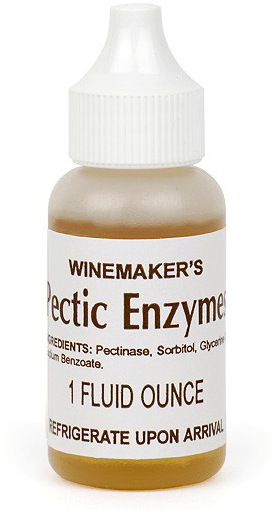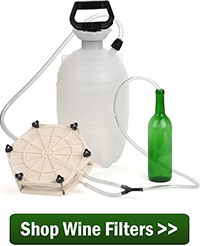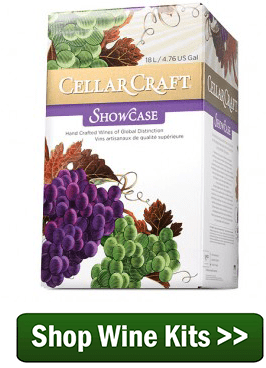 Can I add pectic enzyme after the fermentation to clarify the wine? Is there a substitute or alternative I should use instead at this time?
Can I add pectic enzyme after the fermentation to clarify the wine? Is there a substitute or alternative I should use instead at this time?
Name: Paul D.
State: Idaho
—–
Hello Paul,
Thanks for the great question. Some beginning winemakers get confused as to when to add pectic enzyme to their wines.
What Is Pectic Enzyme?
The first thing that needs to be understood is that pectic enzyme is not a fining agent or a wine clarifier for wine. It does not clear cloudy particles out of a wine after a fermentation like fining agents. Pectic enzyme is a protein that breaks down pectin in the fruit.
Pectin is the gelatinous material in fruit. It’s the stuff that holds the fruit’s fiber together. It is also the stuff that causes the resulting fruit juice to have the appearance of being cloudy. This is known as a pectin haze.
Once the fruit is crushed and pressed, not only does it release the juice, but it also releases the pectin. The pectin is a highly complex carbohydrate, refracting any light that hits it. This gives the fruit juice a cloudy appearance.
The pectic enzyme is a protein that is capable of breaking down the pectin cells into carbohydrates that are less complex – something that does not refract the light and give the juice a cloudy appearance. Essentially, the pectic enzyme causes a molecular change in the juice. It does not do anything to clear out a substances like a fining agent would; it changes the molecular structure of what’s there so that light may travel more cleanly through it.
When To Add Pectic Enzyme To Your Wine?
As for winemaking, the optimum time to add pectic enzyme is right after crushing the fruit and before pressing. By breaking down the pectin cells at this stage, you are allowing more juice to release from the fruit’s fiber – a good thing for making wine. If you are not the one doing the crushing and pressing, then the second best time to add pectic enzyme to your wine is at the beginning of the fermentation. This will allow the pectic enzyme to do its thing while the wine fermentation is occurring.
Three Things To Note Here:
- Pectic enzyme comes in different strengths, so you are better off using the dosage recommended on the package it comes in instead of following the amount called for in your wine recipe.
- During a wine fermentation the wine yeast does produce some pectic enzyme of its own. This is why it is possible to have a clear wine without adding pectic enzyme, but you are playing cloudy roulette with your homemade wine by not adding it. Adding pectic enzyme to your wine gives you added insurance that you are going to have a clear-looking wine.
- If you do end up with a cloudy wine after the fermentation and you’ve already cleared out all the physical particles with a fining agent such as bentonite or isinglass, your options are few. Pectic enzyme is much more effective during a fermentation than after a fermentation. Your only hope is to add another full dose of pectic enzyme directly to the wine and give it time (sometimes months) to work on breaking down the pectin cells. If you did not add a dose of pectic enzyme at the beginning of fermentation, then you can add a double-dose, now. Pectic enzyme works much slower after a fermentation has completed.
 Unfortunately, there is no alternative or substitute for pectic enzyme. So if you think you need some, you’ll have to get some. Do not use gelatin from the store. It will not disperse as evenly and readily as gelatin offered by wine supply shops.
Unfortunately, there is no alternative or substitute for pectic enzyme. So if you think you need some, you’ll have to get some. Do not use gelatin from the store. It will not disperse as evenly and readily as gelatin offered by wine supply shops.
I hope I’ve answered your questions and given you a more complete understanding of what pectic enzyme is and what it does for the home winemaker. Just remember it is at the beginning of fermentation that you when you’ll want to add pectic enzyme to your wine. If that ship has sailed, you can add a double-dose of pectic enzyme after the fermentation.
If you’d like to read more you might want to take a look at Why Do Wine Recipes Call For Pectic Enzyme.
Happy Winemaking!

i have been looking for a recipe for kumqurt wine i have found tht tells you what to put in it.but does not tell you a ny instructions so there fore i just frozen the kuqs!
Barbara, the steps for making wine from a fruit are pretty much the same regardless of the fruit. The recipe is the bigger hurdle, which you have. Here is an article our are website that will give you just what you need: "How To Make Homemade Wine" http://www.eckraus.com/wine-making-steps/
Ed, I’ve been making wine on and off since 1964—and I’m still learning, thanks to your articles. I got started with very brief recipes from Ireland, using anything that grew–excluding woody plants. Things got easier with cans of concentrates. And now it’s quite simple making wines from kits. But with poor techniques and practices, up jumps the devil with a problem. That’s where you come to the rescue and I will occasionally slip back to those beginning recipes, which incidently didn’t include ANY refined instructions. So I "Salude"! to you and sip the nectar.
I have been taught to freeze the fruits for making wine; so that when thawed the fruit nauturally breaks down to a juicy mush. Is there a different way to extract the juices? Do not have a press and not familer
with any other way.
Thank you
Is there a way to sweeten before bottling using teh hydrometer as the guide as to how much sweetner/sugar to add? Vs. sampling / adding/ sampling and etc?
Danny, freezing the fruit it great. It allows you to make wine when YOU are ready, and like you said, it allows more juice to release. Even though you do freeze your fruit I would still suggest that you crush the fruit up after thawing and add it into the wine must, itself. (I get the sense you are using just the juice in the fermentation) I would also suggest that you used pectic enzyme in the fermentation as discussed above.
Daniel, I have seen directions that tell you to sweeten your wine until you reach a specific reading on your hydrometer. But the truth of the matter is that the range on the hydrometer that would relate to a finished sweet range is so narrow that hitting it with any accuracy is very difficult. Also, I have to mention that I am not a fan of this method, simply because each wine is different, and the right amount of sweetness for one might not be the same for the other. Your best option is to sweeten to taste. If this scares you, take a measured sample of the wine, and sweeten it to establish a dosage for the rest of the batch. If you mess the sample up, just pour it back and start all over with a new sample.
I enjoyed reading about the making and problems with wine. I would like to know if the wine (at bottling time) is too sweet, is there anything a person can do about this?
Joyce, if you wine is too sweet at bottling time, there is very little you can do. This is assuming that the fermentation produced a reasonable amount of alcohol 10% to 14%. You might try blending it with another wine later. If the wine did not produce a reasonable amount of alcohol, you need to figure out why and fix the problem, so that the fermentation will finish.
Can I use papaya enzyme tablets (which is a dietary supplement for digestive problems) instead of pectic enzyme for wine making?
JJay, there are an endless array of enzymes in nature, each one completely different from the other. While papaya enzyme is an enzyme (I’m basing this by what you are calling it), I doubt if there is anything else that connects it to pectic enzyme. You need an enzyme that will specifically break down pectin cells. This takes a particular type of enzyme.
is the pectic enzyme needed/useful if you use juice concentrate?
Rene, because pectic enzyme enhances the clarification process, I would use it with the canned concentrates.
Hi re: ” Do not use gelatin from the store. This is the opposite ofvwhatvyou are looking to do.”
Why is this so? I had the impression that gelatin could be used to clear some wines.
Many Thanks
DJ, actually saying “that is the opposite of what you want to do” was not a correct statement. Thank you for bringing this to our attention and we are correcting the article right away. Regarding your question, the reason that we recommend using the type of gelatin fining that we carry is because it has a 250 bloom count and will disperse more evenly and readily than gelatin purchased at the grocery store.
I’ve hewrd it’s possible to use papaya peel as peftic enzyme. Is this feasable? I live in Colombia, lots of papaya, not much pectic enzyme…
Marc, while it is possible to use papaya in place of pectic enzyme, it is not very practical. Unfortunately, we do not have any information on how you would do so.
So adding after fermentation is the least effective method? What about during fermentation if you have forgotten? Thanks TRBB
TriRegionBestBuds, if you forget to add pectic enzyme in the beginning and add it during fermentation, we recommend adding a double dose.
Hi,
Does kmeta have any adverse effect on pectic enzyme? Can I add the enzyme and kmeta at the same time?
Yes you can. There is no interaction between the two.
So, I am hearing a lot about pectin and fermentation to levels of about 10 to 14%. All of my fermentations to date have yielded 32 to 46 abv. My problem is not too sweet or too dry, it is simply put too much fermentation.
Any ideas folks?
It isn’t possible for wine yeast to reach that high of ABV. You are perhaps reading the hydrometer incorrectly unless you are distilling your wine? The only way to reach anything over 12 or so percent is to use turbo yeast which can hit 24% or to distill the alcohol.
Can you add baking soda to decrease acidity if too high? Say going from a 2.5 to 3.5ph? If so how much would you add to 5 gallon must?
Gary, I am sorry; we do not have any experience using baking soda to remove excess acid in wine. As far as we know, it is not a common practice to use baking soda/sodium bicarbonate in wine. We do carry Acid Reducing Crystals (Potassium Bicarbonate) to help reduce the acid in your wine.
Will adding pectin be a bad idea if my goal is a wild/natural fermentation?
Jonathan, adding pectic enzyme is always a good idea when using fresh produce because it aids in the clarification of the wine. It also helps break down the fiber so that you can extract more flavor.
Scott Labs Spectrum is a blend of enzymes that can be added post-fermentation.